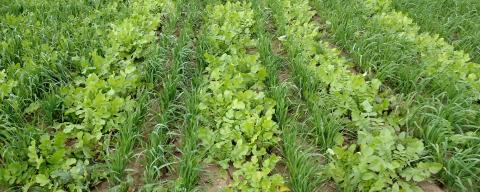There are many reasons for using cover crops in the home garden. Cover cropping can be a tool to prevent weeds, improve the soil by limiting erosion and adding nutrients, and reduce pest damage. This fact sheet provides an overview of the most common reasons to use cover crops at home and lays out the most successful options for gardeners in New Hampshire.
What Are Cover Crops?
In general, cover crops are specific plant species that are planted for a purpose other than growing a harvestable crop. They “cover the ground” when the “cash” or “main” crop we desire is not growing. Remember, cover crops are plants, and they have their own growing requirements and characteristics. When selecting a cover crop for your garden, think of these questions:
- What do I want to achieve?
- Will this grow successfully in my climate?
- How will this fit in my garden?
- How and when will I plant, maintain and terminate the cover crop?
What Do Cover Crops Do?
Nutrients
Cover crops can help provide essential nutrients to your garden soil. Species that are legumes, such as clover and peas, form a symbiotic relationship with Rhizobia bacteria. These bacteria can take nitrogen from the air and convert it into a form that is usable to plants, a process called nitrogen fixation. In return, the bacteria live in small “galls” on the roots of the legumes, known as root nodules, and are supplied carbohydrates from the plant. Once the legume cover crop dies, this nitrogen is released back into the soil for the following crop to use. Other cover crops such as rye, oats and tillage radish are known as scavengers. Their root systems can find nutrients within the soil profile that may be unreachable or unused by crops outside the growing season. These cover crops then uptake those nutrients and incorporate them into their tissues. Upon termination of the cover crop, the nutrients are then released back into the soil where the following crop can access them. Scavengers are good options because they take up more nutrients than they need for growth and in doing so prevent nutrients from getting lost through leaching and erosion.
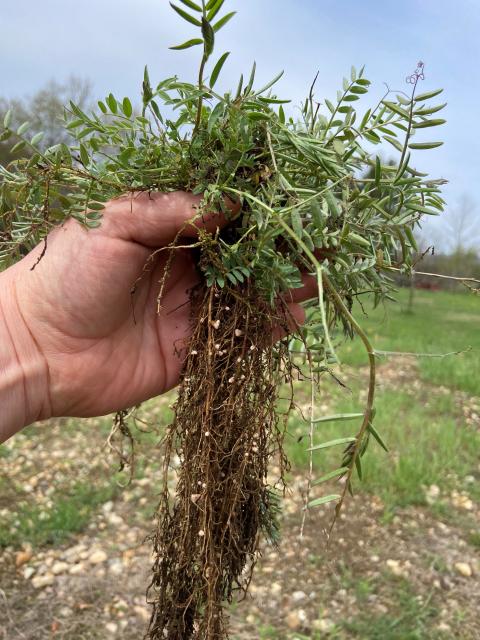
Nodules on legume species like hairy vetch contain bacteria that contribute nitrogen to the soil.
When cover crops die, they decompose adding organic matter to the soil. Organic matter works in supplying nutrients in two ways. Cover crops provide a feedstock for microorganisms that aid in decomposition and are part of soil nutrient cycles. The decomposition process releases nitrogen; therefore adding organic matter to the soil increases your long-term supply of nitrogen, which is slowly released to your crop. Organic matter also increases the soil’s ability to hold on to other essential nutrients such as calcium, magnesium and potassium. Soils with high organic matter often need less nitrogen fertilizer.
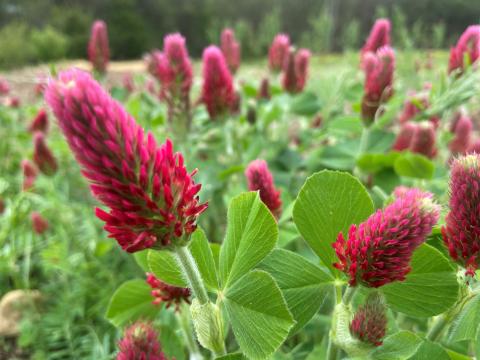
Crimson Clover
Soil Properties
Cover crops can help alter the physical properties of the soil. Cover crop root systems hold the soil in place, keeping it from washing or blowing away. This likely is not a huge concern in raised bed gardens, but in-ground gardens, especially on slopes, benefit from this attribute. Cover crops protect soil by blocking rain-fall. Rain that meets loose, bare soil can break up larger soil particles and cause compaction. Cover crops also alleviate compaction through their roots, which can penetrate compacted layers in the soil. This can improve water infiltration and increase soil friability. When the cover crops die and the roots decay, they leave pathways called pores in the soil. These help with soil drainage and aeration. Furthermore, the organic matter created by decaying cover crop residue acts as a glue that helps bind soil particles together. This soil binding, called aggregation, promotes the formation of soil pores by increasing soil particle volume and making the soil more resilient to compaction.
Pollinator/Beneficial Habitat
Cover crops can provide habitat and forage for pollinators and beneficial organisms. Pollinators will benefit from cover crops that produce flowers, such as clover, buckwheat, pea, radish and sunflowers. Some beneficial insects (the natural enemies of crop pests) also benefit from pollen and nectar during parts of their life cycle. Cover crops also provide habitat for other insects that are not crop pests but serve as a food source for beneficial predators and parasitoids when the crop pests are absent.
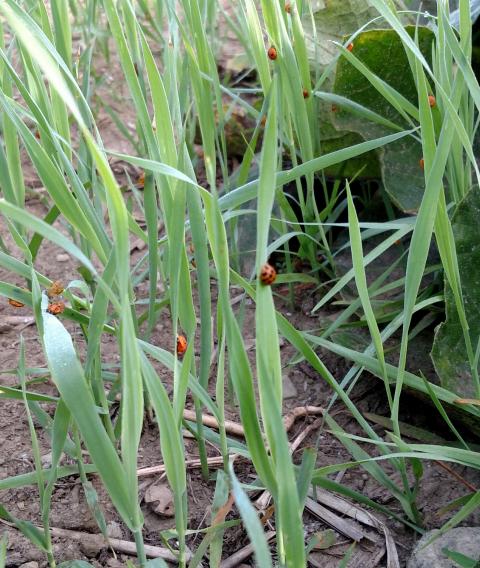
Ladybugs on oats interseeded with winter squash. Cover crops are good habitat for beneficial predators.
The Role of Cover Crops in Pest Cycles and Crop Rotations
Cover crops can be used to break pest cycles. The general concept involves removing the host and letting the pest move on or die out. However, success can vary depending on the specific pests, crop and environment. However, their use in small home gardens can be limited for this because of the small distance between plantings, even with rotations. Typically, crop pests favor certain plant species or plant families. Many insects and plant diseases overwinter in the soil or crop debris nearby where these favorable plants last grew. When crops from the same family are repeatedly planted in the same place, there tends to be a buildup of pest insects in the local area. The same can be considered when talking about plant pathogens, like bacteria, fungi and viruses. With that in mind, consider planting cover crops that are from different families or genera from your vegetable crops, since pests can have multiple hosts within these classifications. For example, if you have just planted a brassica (broccoli, cauliflower, cabbage, etc.) you would not want to follow that with tillage radish, which is also a brassica. Alternating between grasses (corn, rye, oats, etc.) and broadleaves (tomatoes, brassicas, squash, etc.) can be an effective practice.

Hairy vetch planted with rye: mixing species can provide a wider range of benefits.
Managing Weeds
Weeds are also important garden pests. Weeds directly compete for resources with crops and can attract crop pests. Cover crops can help fight weeds in a few ways. First, they can out-compete the weeds for resources by shading them out. Essentially, cover crops are out-weeding the weeds! Second, it is possible to obtain a high amount of plant biomass with some cover crops; upon termination this biomass can act like a mulch on top of the soil, blocking weeds. Lastly, some cover crops (mostly small grains, and especially winter rye) contain natural chemicals that are harmful to other plants (allelopathy). These chemicals can inhibit the growth or germination of other species, like weeds. However, keep in mind that these other species could also be your crop.
A common way of managing cover crops in New Hampshire is to sow them sometime towards late summer or early fall and terminate them the following spring, shortly before planting. This leaves the growth they accumulate throughout the fall and early spring to protect the soil. Occasionally, gardeners might leave a cover crop in place for an entire growing season or longer to control hard-to-kill perennial weed species.
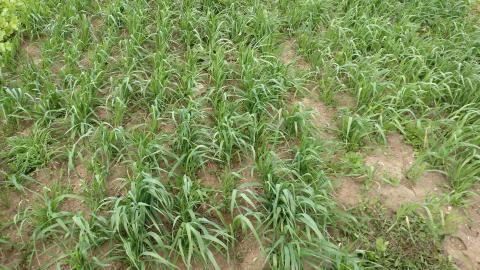
Oats competing with weeds.
Common Species
An effective cover crop needs to be able to put on enough growth to shield the soil surface from the impact of precipitation and anchor the soil in place with its root system. Because they are planted towards the end of the growing season, they should be cold hardy enough to continue growing into fall. Species that stay dormant over the winter and resume growth in spring provide additional protection to the soil and help to crowd out early flushes of weeds.
We tend to draw on certain families of plants for suitable species of cover crops. Winter cereals, including rye, wheat, and oats, are cold tolerant and will continue growing late into the fall (though oats are not winter hardy). Legumes, such as field peas, hairy vetch, or various species of clovers, have the benefit of fixing nitrogen, as well as providing benefits to pollinators. Brassica species including daikon radish and turnips, have large leaves that provide good protection quickly, and large taproots that take up remaining soil nitrogen.
A combination of species offers more benefits than one, and many gardeners sow a mix of cereal grains, legumes, and other species to maximize the overall benefit they get from their cover crop. However, mixtures can also be more difficult to manage due to differences in planting dates or growth habit, and it is worth noting that even monoculture stands still provide many benefits.
Establishing, and Terminating, Cover Crops
Timing is one of the most important considerations for sowing cover crops; seeding late in the season doesn’t leave enough time for seedlings to put on sufficient growth for effective cover, and they may not be able to develop root systems strong enough to survive the winter. While robust species like winter rye can be sown as late as early October and still provide some benefits in southern parts of the state, slower-growing species such as hairy vetch or clovers should be sown no later than September 15. There is no need to use a rototiller for preparing the seedbed; gardeners can scratch the soil lightly with a rake or hoe prior to seeding and lightly firm the soil afterwards to provide the soil/seed contact necessary for germination. Refer to the table below for species-specific recommendations.
Terminating cover crops at the beginning of the growing season prevents them from competing with vegetables. Tilling the soil one to two weeks prior to planting - before stems start to elongate on cereal grains - is usually an effective way to kill off the cover crop and incorporate its residues into the soil. When tillage is impractical, use a non winter hardy species so that no living plants remain by spring. Peas and oats are not winter hardy, but will still provide a thick layer of residues to protect the soil from erosion without leading to problems when it is time for planting.
Species, Winter Hardy (Y/N), N benefit (S=Scavenging,F=Fixation) , Season, Best Planting Date, Rate - oz. per 100 ft2, Comments
- Rye - Y, S, Fall, 15-September, 5, May be difficult to terminate if left to grow after late May.
- Wheat - Y, S, Fall, 15-September, 5, Less winter hardy than rye.
- Oats - N, S, Fall, 15-September, 5, Feed-grade oats are acceptable for small plots.
- Sorghum - N, S, Summer, 1-June, 2, May be difficult to incorporate if left to grow more than 3 feet tall.
Legumes
- Hairy Vetch - Y, F, Fall, 30-August, 2, Reseeds itself readily, can become a weed.
- Crimson Clover - Y, F, Fall, 30-August, 2, Marginally winter hardy in many NH locations; Attracts pollinators.
- Sweet Clover - Y, F, Summer, 30-April, 1.5, Slower growth, ideal for green manures.
- Red Clover - Y, F, Summer, 30-April, 3, Slower growth, ideal for green manures.
- Sunn Hemp - N, F, Summer, 15-June, 1
- Field Peas - N, F, Summer, 15-April, 4
- Austrian Winter Peas - Y, F, Fall, 30-August, 4, Type of field pea winter hardy to 10øF. Does not consistently overwinter in most NH locations.
- Brassica spp - N, S, Fall, 30-August, 0.5, Can be vectors for pests in cabbage, broccoli, etc.
- Buckwheat - N, S, Summer, 1-June, 2, Attracts pollinators. Double rate for "smother crop" to manage weeds.
Cover Crop Challenges
For all the benefits they provide, cover crops can frustrate gardening efforts when they are not managed properly. Terminating them too late can result in excessive, coarse growth that can be difficult to incorporate with tillage and can even temporarily tie up soil nitrogen. Because they are closely related, brassica cover crops can harbor the same diseases and insect pests that affect broccoli, radishes, bok choi, and other vegetable crops, such as wireworms and tarnished plant bug.
It is also good to remember that soil improvement takes time even with a full commitment to using cover crops. Most home gardeners have limited flexibility in leaving fallow areas for green manures to grow for an entire growing season, and limited space for using crop rotations that provide the most benefits for managing pests. Even so, cover crops can work with small gardens or a few raised beds.
That being said, any use of cover crops is beneficial, and those who find ways to incorporate them more into their gardens will be rewarded for their efforts.
References
1. Pollinator/Beneficial Habitat:
https://www.sare.org/wp-content/uploads/Cover-Cropping-for-Pollinators-…
2. Managing Cover Crops
3. Table: Managing Cover Crops Profitably - 3rd Edition, Published in 2007, S.A.R.E.
Extension Services & Tools That Help NH Farmers Grow
Newsletters: Choose from our many newsletters for production agriculture
Receive Pest Text Alerts - Text UNHIPM to (866) 645-7010
